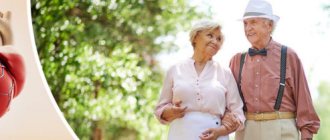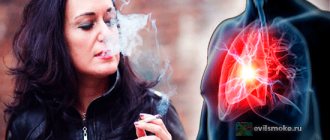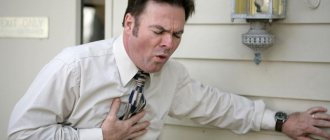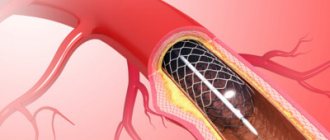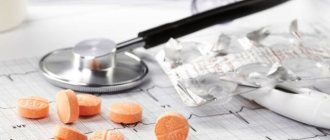Home » Articles from an expert » Heart
A massive heart attack is the most dangerous form of heart attack. It poses a serious threat to human health and life.
Many people are unaware that pathological processes are developing in their body. Diseases of the cardiovascular system can remain hidden for a long time. A critical condition occurs unexpectedly and for no apparent reason. If the victim is not given immediate medical assistance at this moment, he may die.
What is myocardial infarction
With small focal ischemia, a small area of the heart muscle is affected. In this case, patients do not face serious consequences. After rehabilitation, the person returns to normal life. Some people even carry the disease on their legs.
A major heart attack is the death of a large area of the heart muscle due to blockage of the coronary arteries by a thrombus. Deprived of oxygen and nutrition, the myocardium loses the ability to fully contract. As a result, blood pressure drops sharply. The person falls into a life-threatening state of cardiogenic shock.
Based on the location of the myocardial lesion, there are:
- anterior wall of the left ventricle,
- back wall,
- the septum between the ventricles.
With transmural infarction, all 3 layers of the myocardium are affected. The width of necrosis sometimes reaches 8 cm.
According to statistics, extensive heart attacks are 4 times more common in men. In women of this age, sex hormones estrogens serve as protection against ischemia. But after 60 years, the incidence rates of the disease are compared.
Extensive heart attack in older people and its consequences
Now we propose to talk about whether people over 70 have a chance of surviving the consequences of a massive heart attack.
Early consequences of a massive heart attack.
The onset of the pathology in question may lead to the following unpleasant phenomena:
- changes in heart rhythm (including ventricular tachycardia and atrioventricular block);
- cardiogenic shock, which means destabilization of the contractility of the heart, leading to disruption of the blood supply to important organs and systems of the body;
- pulmonary edema;
- cardiac rupture - occurs due to thinning of myocardial tissue and often leads to death;
- disruption of the functioning of the human immune system, which provokes the development of pericarditis, pleurisy and polyarthritis.
Late consequences of extensive infarction.
It is worth noting that the negative consequences may have a cumulative effect or may not appear immediately after damage to the heart muscle, but some time after the clinical picture improves. These include:
- chronic heart failure, which is provoked by destabilization of contractile function;
- aneurysms - protrusion of the heart wall in the affected area;
- the formation of blood clots, which can cause thromboembolism.
Causes of heart attack
The basis for the occurrence of acute ischemia is atherosclerosis of the coronary arteries. Plaques literally clog the coronary vessels. Increasing in size, they narrow the lumen of blood vessels, where blood flow slows down. This causes red blood cells to stick together. As a result, blood clots form.
In such a critical state of the blood vessels, psycho-emotional agitation, a rise in pressure, overeating, and alcohol consumption can cause plaque rupture with damage to the inner wall of the artery. “Repair” occurs when a red blood cell clot forms. In this case, blood clots are formed, producing substances that cause vasospasm.
Blood clots can spread along the vessels, reaching 1 cm. It is worse when they grow across the arteries. When a vessel spasms, blood flow can completely stop. This is when acute ischemia of the heart muscle occurs.
This is interesting! A quarter of an hour after the blood flow stops, the corresponding zone of the heart muscle dies, and the picture of myocardial infarction develops. Connective tissue develops at the site of necrosis, and a week later a post-infarction scar begins to form.
Treatment with folk remedies
After being found and discharged from the hospital, the patient will have to take medications and follow the doctor’s instructions for a long time. But the treatment regimen can be supplemented with traditional methods. Of course, they will not provide complete healing, but they can increase the effect of the main course.
All products include natural ingredients that saturate the heart with beneficial substances. They can only be used with the doctor’s permission, so as not to spoil the basic therapy regimen.
Let's consider proven popular recipes:
- Birch buds accelerate the regeneration process, cleanse the blood, and relieve inflammation. The decoction is prepared as follows: 10 buds are poured with 200 ml of boiling water, and they are boiled for 15 minutes. After the broth has cooled, the raw material is removed, and 120 ml should be taken between meals.
- Garlic normalizes blood clotting and reduces cholesterol levels. Recipe: chop 1 head of garlic and 3 lemons, mix and pour in 30 ml of honey. Let it brew for a week and take 10 g daily.
- Valerian has sedative properties. You can make an excellent collection using other herbs. This collection includes: sage, calendula infusion, lavender and angelica. Everything is taken in equal shares. 120 g of collection is poured into 1 liter of boiling water and left to infuse overnight. In the morning, you need to strain, removing the raw materials, and take 1/3 cup twice a day for 2 months.
- Hawthorn – reduces nervous excitability and stabilizes heart function. 30 g of hawthorn fruits are ground and poured into a glass of boiling water. After the infusion has cooled, you need to take the raw material out of it and drink 250 ml after waking up and before going to bed.
Risk factors
The development of vascular accident is influenced by factors contributing to the occurrence of myocardial ischemia. Layering on coronary arteries altered by atherosclerosis leads to extensive myocardial infarction.
Causes of ischemia of the heart muscle:
- Arterial hypertension leads to thickening of the vascular walls. In this case, the arteries become inelastic and lose their adaptive ability to expand and narrow at the right moments.
- Abdominal obesity is a direct road to arterial hypertension and the formation of atherosclerotic plaques. In addition, excess weight creates additional stress on the heart.
- A physically inactive lifestyle contributes to blood thickening,
- Diabetes disease is characterized by fragility of blood vessels. Vulnerable walls are more susceptible to atherosclerosis.
- Prolonged psycho-emotional stress is accompanied by spasm of the coronary arteries. In combination with atherosclerosis, myocardial ischemia increases.
- Smoking, which destroys blood vessels from the inside, causes vasospasm.
- Lipid disorders – high levels of “bad” cholesterol create the basis for the development of a heart attack.
- Unbalanced diet, consumption of foods containing saturated fats.
- Atrial fibrillation is accompanied by the formation of a blood clot inside the heart cavity.
- Alcohol abuse destroys blood vessels, provokes the development of hypertension, and disrupts the functioning of the liver, which is responsible for processing fats. Excess lipids are deposited on the inner walls of arteries and veins.
- In case of kidney disease due to impaired mineral metabolism of phosphorus and calcium, the latter is deposited on the inner walls of the arteries. This makes them tough. Blood clots easily form on altered vessels.
Myocardial infarction occurs from physical overload. Under conditions of increased myocardial oxygen demand, the arteries are unable to provide blood flow. There is a sharp deficiency of oxygen and nutrients, which leads to acute ischemia. This situation can occur during competitions or training among athletes.
Disease prevention
Preventive measures are aimed at preventing the development of heart disease. For this:
- Stop smoking, which increases the risk of heart attack by almost 50%.
- Limit your consumption of alcoholic beverages.
- Form a daily and rest routine in which at least 7 hours will be allocated for sleep.
- Limit the amount of animal and vegetable fats in your diet.
- Eat more protein foods, beans, fruits, lean meats and fish.
- Exercise and do cardio exercises.
Along with the above, it is necessary to constantly monitor blood pressure and cholesterol levels and lower the levels as they increase.
Read on to learn how life can turn out after a major myocardial infarction and what the consequences are for the heart.
You can prevent the development of a heart attack if you are careful about your health and prevent the formation of sclerotic plaques in the vessels. To do this, you must follow the following recommendations:
- Include more fresh vegetables and fruits that contain fiber in your diet.
- Reduce consumption of fatty, smoked and fried foods.
- Lead a healthy lifestyle.
- To prevent stress, master relaxation techniques.
- Control blood sugar and cholesterol levels.
- Treat chronic pathologies.
- Consult a doctor if you experience angina attacks.
Myocardial infarction is a serious cardiac disease that can lead to death, but every patient, subject to medical recommendations, can prevent this terrible pathology.
Signs
A heart attack occurs suddenly and strikes a person at work, in a public place or at home at the table.
The clinical picture may vary, but the first signs remain constant:
- intense pressing pain behind the sternum, radiating to the left shoulder, arm, ear or shoulder blade,
- excessive sweating,
- numbness of the left hand,
- pale skin,
- unconscious feeling of fear,
- decrease in pressure,
- tachycardia,
- arrhythmia,
- weakness,
- if the posterior wall of the myocardium is damaged, the symptom is abdominal pain, vomiting without relief,
- Doctors are also aware of a painless form of acute infarction, which also requires emergency measures. A heart attack can happen again after a few minutes or hours.
During a heart attack, the pulse quickens and becomes irregular. The person is literally drenched in cold sweat, breathing intermittently. The picture is complemented by dizziness and sudden weakness throughout the body. There is panic on the victim’s face; he looks confused, not understanding what is happening to him.
Infarction of the anterior wall of the heart: causes, symptoms, methods of treatment and diagnosis
Inferior, posterior or anterior myocardial infarction is diagnosed in the same way. First, I always collect a medical history and evaluate the patient's complaints. Most often, chest pain alone is enough to raise suspicions.
To confirm my guess, I use auxiliary instrumental and laboratory examinations.
The basis for diagnosing any myocardial infarction is an ECG. It is impossible to overestimate the importance of the electrocardiogram in ischemic heart disease. The technique allows you to see on paper or a screen the slightest deviations in the electrical function of the heart, which always occur when the supply of certain areas of the myocardium with blood is disrupted.
Possible changes on the film:
- elevation (rise) or depression (subsidence) of the ST segment relative to the isoline;
- inversion (change of polarity to the opposite) of the T wave;
- formation of a deep and wide (pathological) Q wave.
To clarify the location and extent of damage to the heart muscle, I always additionally prescribe the following studies:
- Angiography of the coronary vessels. After contrast is injected into the coronary arteries, I see the blockage site on the monitor screen, which allows me to quickly restore the patency of the vessel using stenting.
- Echocardiography (Echo-CG). Ultrasound examination of the heart allows you to see a decrease or complete absence of contractions of the affected area of the myocardium (hypo- or akinesia).
In 98% of cases, the instrumental methods described above are sufficient to make a final diagnosis.
Laboratory methods
Additional laboratory tests:
- General blood analysis. During a heart attack, the number of leukocytes may increase and the erythrocyte sedimentation rate (ESR) may increase.
- Blood chemistry. The amount of C-reactive peptide, AST, and ALT may increase.
- Coagulogram. The analysis demonstrates the function of blood clotting. In heart attack patients it is often too pronounced.
The diagnosis of MI should be made as quickly as possible.
Symptoms:
- Pressing pain or burning sensation in the chest or heart.
- Pain radiating to the neck, jaw, shoulders, arms, or upper abdomen.
- Dizziness, feeling weak, sweating, lack of air, irregular heartbeat.
- Suffering, pale face.
- Pain that lasts more than 30 minutes.
But these symptoms are not always typical. In 10% of cases, pain is absent or reduced to pain in the arm, sometimes of an isolated type.
These cases are especially relevant for elderly patients or diabetics. Atypical manifestations may include collapse, neurological pathologies, and gastrointestinal dysfunction.
What to do before the doctor arrives
A person with an acute myocardial infarction may die if treatment is not provided on time. If you have heart pain, you should first of all call an emergency cardiology team. The faster professional therapeutic measures are provided, the greater the chance of survival.
Wherever a person has a heart attack, people around them can provide essential first aid:
Attention! The patient cannot walk.
- The victim should be placed on his back with his chest elevated to reduce the load on the heart. To do this, folded clothes or a blanket are placed under the upper body. But if blood pressure is low and the pulse is hard to feel, the head should be lower than the body. This will preserve cerebral blood flow. In case of severe shortness of breath, to facilitate the work of the heart, the patient is seated with his legs down.
- During a heart attack, you need to ensure free breathing; to do this, you need to unbutton the collar of tight clothing, take off your tie, and open the window for fresh air.
- Give Nitroglycerin under the tongue.
Attention! It should not be used for low blood pressure, weak pulse, or pale skin, so as not to aggravate the patient’s condition.
- Nitroglycerin during a heart attack does not immediately relieve pain, unlike an attack of angina. Therefore, the second tablet can be used no earlier than 15 minutes later.
- Give half an Aspirin tablet. To speed up the effect, the medicine must be chewed.
- If a patient with a heart attack is unconscious and the heartbeat has stopped, resuscitation begins immediately. One person performs indirect cardiac massage with a frequency of 80–100 compressions per minute on the lower third of the sternum. If there are two assistants, take 2 breaths for every 15 chest compressions.
These measures help save a person before the doctor arrives.
By the way! Indirect cardiac massage, while maintaining hemodynamics, makes defibrillation more effective upon the arrival of a cardiologist.
Often, a catastrophe in the heart is manifested by pain and burning in the abdomen - the so-called abdominal form of myocardial infarction. Those around you give gastrointestinal remedies. If, after taking Rennie, Maalox and other antacids, the burning sensation in the stomach does not go away, you need to call an ambulance.
Rehabilitation period
The recovery stage after myocardial infarction can last differently. This process is influenced by many factors.
What determines the duration and nature of rehabilitation:
- concomitant diseases;
- severity of the attack;
- presence of complications;
- the patient's occupation;
- age data.
During the recovery period, a person needs to reconsider his lifestyle, habits and preferences.
Rehabilitation includes:
- proper nutrition;
- absence of stressful situations and worries;
- physical activity that needs to be developed gradually;
- visits to a psychologist;
- taking all medications prescribed by a doctor;
- weight loss, if it is excess;
- rejection of bad habits;
- regular examinations and consultations with the treating doctor.
Nutrition for patients who have suffered a myocardial infarction is divided into 3 stages. A general description of the diet can be seen in diet menu No. 10.
- The first step is the table of a person who is in an acute period of illness. Meals include dishes without added salt, boiled or cooked in a double boiler. It is better to eat pureed food, in small amounts, but often, 5-6 times a day. Liquid is also limited, 0.8 liters per day is enough.
- In the second or third week of the post-infarction period, the patient's menu changes slightly. You need to prepare food in the same way, but you can eat it not pureed, but lightly chopped. The diet is fractional, and water is allowed in a volume of about 1 liter.
- The scarring stage may allow inhibitions to be slightly reduced. The method of preparing dishes remains the same, but it is permissible to eat them in pieces, and the doctor often allows salt, but in the amount of 4 grams per day, and only for some patients. Eating should be done frequently, up to 5-4 times a day.
There is a special menu preferred for such patients. These products and dishes contain a large number of useful elements, especially necessary for people who have suffered a myocardial infarction. When discharged from the hospital, you should ask your doctor to draw up a similar memo, with the help of which it will be easier for patients to navigate when developing a personal diet.
Recommended menu:
- low-fat fish;
- lean meat, preferably chicken or veal;
- soups made from pureed vegetables and cereals;
- fermented milk drinks with a low fat content;
- egg white omelet;
- bread, crackers;
- butter is acceptable to a minimum, and by the 3rd stage up to 10 grams is possible;
- boiled vegetables, stew;
- baked fruits;
- drinks in the form of fruit drinks, compotes, loosely brewed teas, rose hips;
- natural honey
There are many dietary restrictions; you need to exclude from your diet a large number of foods that can negatively affect the health and activity of the human heart.
What is prohibited:
- fatty meat in any form;
- egg yolk;
- fresh bread;
- canned foods;
- radishes or turnips;
- sausage of all types;
- offal;
- fresh cabbage;
- rich and sweet baked products;
- all legumes;
- garlic and hot seasonings;
- grapes or their juice;
- alcohol;
- margarine;
- all types of pickles;
- chocolate.
When the body recovers, dietary restrictions can be lifted, but this must be done gradually and only under the supervision of a doctor.
Emotional overload often provokes serious health problems, especially with heart disease. After a myocardial infarction, the patient should absolutely not be nervous, since any excitement can cause a rhythm disorder in the main organ and lead to vasospasm, which provokes a repeat attack. To cope with emotions and survive the illness, the patient is prescribed a course of therapy with a psychologist. The doctor will help you recover, without manifestations of nervousness and fear.
Physical activity is necessary for such people, but all actions are coordinated with the doctor. Within a few days after the attack, patients are allowed to get out of bed and walk around the ward a little. Walking in the fresh air allows a little later, and the distance that such a person can walk increases gradually. With the help of physical activity, it is possible to restore normal blood circulation and heart function. It is important during sports warm-ups not to bring the situation to the point of pain or other unpleasant sensations, this can provoke a recurrent attack. Exercise therapy procedures are prescribed to many patients after a heart attack. During these sessions, all stress on a person is controlled by a specialist.
Rehabilitation measures should not fade into the background if your health has improved. The duration of this period is regulated only by doctors, and you cannot stop these actions on your own.
Traditional treatment
Plants and other homemade medicines can help you recover from such an illness. But before using any of these remedies, you need to coordinate your actions with your doctor.
Methods of traditional therapy:
- Sprouted wheat. Take several glasses of wheat and soak them in gauze with water. Wait until sprouts appear (it will take several days). Break off these sprouts and eat 1 teaspoon in the morning on an empty stomach.
- Hawthorn. Pour one tablespoon of dried hawthorn fruit into a glass of boiling water, leave for half an hour, strain and drink. You need to take 2 glasses of this drink per day.
- Honey and rowan. Take 2 kg of honey and 1 kg of fresh rowan fruits. Grind the berries and mix with honey. Eat 1 tablespoon throughout the day.
The prognosis for myocardial infarction is impossible to predict, but every person is able to help himself. By following all the doctor’s recommendations and additionally using folk therapy, people improve their well-being and heart activity, thereby reducing the risk of death and recurrent attack.
Diseases of the main organ can lead to death, therefore they are considered one of the most dangerous. Medicine today cannot prevent the development of such a disease, but it has the ability to carefully examine the patient and find any disease. It is necessary to regularly visit clinics, undergo diagnostics and consult a doctor in order to detect heart pathology at the initial stage of its development, which will help prevent myocardial infarction. Even a regular electrocardiogram of the main organ can reveal the slightest deviations in its functioning. ECG results may be a reason for further examination of a person if abnormalities are detected in them.
Course of myocardial infarction
Cardiologists distinguish several stages of acute ischemia:
- The acute phase lasts up to 2 hours.
- The acute stage lasts for 4–8 days, when a zone of necrosis forms in the heart muscle. During this period, heart pain decreases, blood pressure begins to rise to normal levels. The patient is worried about shortness of breath, rapid heartbeat or interruptions.
- Subacute stage starting from the second week. A scar gradually forms in place of the dead tissue. Conductivity is restored in the heart muscle. By the end of the month after the attack, the heart rhythm returns to normal and blood pressure stabilizes.
- The post-infarction period begins after 8 weeks and lasts up to 6 months.
The scar in the heart muscle thickens. The myocardium develops compensatory mechanisms that help patients survive. The prognosis of myocardial infarction depends on who is next to the patient at the very beginning of the heart attack and how much assistance can be provided.
What determines life expectancy?
Life expectancy after a heart attack varies widely. Scientists analyzed cases of death and compiled a list of factors that increase the risk of death.
There are several approaches to determine the prognosis. The TIMI system, which determines the risk of death in the next 2 weeks, has gained the most popularity. It is very easy to use and quite accurate. Each risk factor is assigned a certain score. Based on the sum of points, you can determine the probability of death.
Extensive heart attack:
- diabetes mellitus, arterial hypertension, angina attacks – 1 point;
- systolic pressure < 100 mm Hg. Art. – 3 points;
- heart rate more than 100 beats/min – 2 points;
- heart failure of 2-4 classes according to Killip – 2 points;
- body weight less than 68 kg – 1 point;
- age over 75 years – 3 points;
- age 65-74 years – 2 points.
Risk of death with a major heart attack (based on total points)
| Points | Probability of death, % |
| 0 | 0,8 |
| 1 | 1,6 |
| 2 | 2,2 |
| 3 | 4,4 |
| 4 | 7,3 |
| 5 | 12 |
| 6 | 16 |
| 7 | 23 |
| 8 | 27 |
| 9-14 | 36 |
Predictors of death for microinfarction are:
- age over 65 years – 1 point;
- 3 or more risk factors for the development of atherosclerotic plaques – 1 point;
- established narrowing of the artery lumen by more than 50% – 1 point;
- use of aspirin over the past 7 days – 1 point;
- serious attack of angina in the last 24 hours – 1 point;
- increased level of markers of cardiac muscle necrosis – 1 point;
- ST wave deviation more than 0.5 mm – 1 point.
Risk of death in small-focal infarction (according to the sum of points)
| Points | Probability of death, % |
| 0-1 | 3-5 |
| 2 | 3-8 |
| 3 | 5-13 |
| 4 | 7-20 |
| 5 | 12-26 |
| 6-7 | 19-41 |
Long-term assessment of life expectancy takes into account:
- timeliness and completeness of medical care during a heart attack;
- level of physical activity;
- person's weight;
- presence of bad habits, especially smoking;
- condition of the valves, chambers of the heart, especially the left ventricle;
- quality of blood pressure control.
The most favorable prognosis is associated with:
- early restoration of normal blood circulation using percutaneous coronary intervention or through the use of thrombolytics;
- preserved left ventricular function;
- timely use of aspirin, beta blockers, ACE inhibitors.
Complications
The sooner qualified assistance was provided to the patient, the fewer consequences there are.
In the post-infarction period complications arise:
- cardiogenic shock,
- pulmonary edema,
- pericarditis,
- thromboembolism,
- cardiac asthma,
- shortness of breath and swelling of the legs are signs of heart failure,
- myocardial rupture.
Complications are associated with the fact that with a transmural infarction, the damage involves a large part of the heart muscle.
ECG for lower infarction
Next, the patient is sent for electrocardiography - a hardware research method that determines changes in the contractile function of the myocardium and blood circulation speed. It makes it possible to identify a blood clot or rupture of a vessel.
Characteristic ECG changes:
- The amplitude of the RV1,V2 wave increases.
- The initial RV1 is expanded.
- The depth of SV1,V2 decreases.
- ST (V1-2) decreases in the acute phase with reverse dynamics.
- The third Q wave widens to 2 mm.
- The second Q wave rises above the first Q.
This type of pathology is difficult to diagnose. Direct signs can only be determined in the Dorsalis lead along the Sky and in the additional chest leads V7–V9. And V2–V4 must be removed between the ribs above. An ECG must be performed several times to clarify the diagnosis.
It is also recommended to conduct additional examination methods:
- Echocardiography is an ultrasound scan that allows you to evaluate the work of the myocardium, the condition of the valve apparatus, measure the thickness of the walls, the level of pressure in the aorta, pulmonary artery, atria and ventricles.
- Radiography is a radiation diagnostic technique that is aimed at identifying pathology of the cardiovascular system.
- Donate blood for general and biochemical analysis.
Forecast
Half of heart attack patients die within a few months. Patients with damage to the posterior wall of the left ventricle have a greater chance of survival.
It is much more difficult for an 80-year-old patient to restore heart function due to the lack of reserve capabilities of the body and wear and tear of the myocardium. In old age, pneumonia often occurs, which goes unnoticed when the clinical picture is blurred. In older people, heart attacks can happen again.
Comorbidities also worsen the prognosis of people of all ages. According to statistics, people live 3–5 years after a heart attack. The reason why patients die is complications. Repeated heart attack often occurs.
After a heart attack, a patient may be assigned a disability group. The criterion is the presence of complications, myocardial contractility. Working conditions are taken into account. Disability is reviewed by a medical and social expert commission consisting of doctors from many specialties.
Advice! You can prolong life after a heart attack if you regularly visit a cardiologist and follow his recommendations. Much depends on the patient’s diet.
The nutritionist will recommend limiting animal fats, coffee, and carbonated drinks. A special role is given to products that help restore the body - cereals, vegetables, fruits, fish. Importance is attached to lifestyle and giving up bad habits.
Non-medicinal methods of influence
Thus, the risk of coronary heart disease and, as a consequence, heart attacks, largely depends on the lifestyle that the patient leads. It has been established that even lifestyle modification has a positive effect on the life expectancy of patients.
Therefore, quitting smoking and alcoholic beverages, switching to proper nutrition and regular standardized physical activity (walking, cycling, morning exercises) are recommended for all patients with cardiovascular risk.
However, it is necessary to take into account the functional state of patients and their tolerance to physical activity.
Indeed, after an extensive heart attack, severe heart failure may develop, which will lead to a significant decrease in possible motor activity and even disability of the patient. Such patients should avoid strenuous exercise.
Life after a heart attack is difficult to imagine without the use of medications. The rehabilitation process involves bringing blood pressure back to normal, treating coronary heart disease and reducing activity in the blood clotting system.
Often, the course of drug treatment includes metabolic agents, cardioprotectors and cholesterol-lowering treatment. In some cases, antiarrhythmic drugs are prescribed.
The course can only be prescribed by a specialist individually for the patient. For example, when arterial hypertension is present, antihypertensive medications are taken every day, and not only during the process of increasing blood pressure. Their task is to maintain the readings of the physical norm. It is necessary to follow all instructions of the specialist.
Rehabilitation
The bulk of rehabilitation therapy after a major heart attack is carried out in special sanatoriums or a medical center. Treatments can be continued at home.
During the rehabilitation period, it is recommended to switch to the right lifestyle:
- give up alcohol and smoking,
- get enough sleep at night,
- avoid stress.
Physical activity should begin with walking, gradually increasing the load. To speed up recovery, you need to do physical therapy exercises under the supervision of a doctor. The rehabilitation program includes special techniques. It is compiled for each person separately by a doctor.
Important! If the rules of the recovery period are strictly followed, the life of patients is extended by several years.
Treatment tactics for large infarction
In order for the consequences after a major heart attack to have minimal impact on the further functioning of all body systems, it is necessary to follow the step-by-step treatment of this pathology.
- The prehospital stage is the provision of assistance before the arrival of the medical team and delivery of the patient to a medical facility.
- Hospital - the use of medications in a hospital setting to stabilize the heart rate, eliminate and prevent the formation of new blood clots, etc.
- Rehabilitation procedures.
- Observation and outpatient treatment.
An acute attack must be accompanied by mandatory placement of the victim in a hospital. In order to remove obstacles to the blood flow to the affected area, thrombolytic therapy is prescribed.
These drugs help eliminate plaque in blood vessels and restore blood flow. The optimal time to take thrombolytics is considered to be the first six hours after a major heart attack. This allows you to avoid the most dangerous consequences.
The following drugs have the effect described above:
- Heparin.
- Aspirin.
- Plavix.
- Prasugrel.
- Fraxiparine.
- Alteplase.
- Streptokinase.
In addition, in order to eliminate pain, the following is prescribed:
- Promedol.
- Morphine.
- Fentanyl with droperidol.
Read material on the topic: Serving the elderly: from nurses to robots
You can stabilize the heart rate after a major heart attack using droppers with a magnesium solution. In addition, calcium antagonists, nitrates and β-blockers are prescribed to activate blood supply. The patient's pronounced feeling of fear is suppressed with tranquilizers.
When taking medications is contraindicated or does not have the desired effect, emergency coronary artery bypass surgery comes to the rescue. Sometimes this is the only possible option to improve the patient's condition.
Having suffered a massive heart attack requires mandatory rehabilitation. Part of the treatment and elimination of the consequences of the pathology that has occurred is compliance with bed rest for 14 days after the attack. At the same time, it is worth minimizing all physical stress on the body: you even need to walk with great care. The standard length of stay in a medical facility is approximately 21 days. Staying under medical supervision is also mandatory for those patients who have suffered a heart attack on their legs.
Clinical picture of the acute form
The symptoms that characterize myocardial infarction differ and depend on the form of the disease. Hypertensive crisis, excessive fatigue, severe physical activity or stress are factors that contribute to the manifestation of the disease.
- Pre-infarction state . Occurs only in half of cases of myocardial infarction. Manifests itself in unstable angina, which has a progressive course.
The most acute condition .
The main symptom is pain of varying severity. Its intensity depends on the area of myocardial damage. Pain can be of different types:
The peculiarity of pain during myocardial infarction is that it radiates to the neck, collarbone, left shoulder, ear, lower jaw, teeth or under the scapula . The pain lasts from half an hour to several days and does not stop after taking nitrates.
Atypical forms of heart attack . In elderly patients with signs of atherosclerosis, atypical forms of heart attack may occur. This clinical picture is often observed against the background of repeated myocardial infarction.
Atypicality is associated with unusual localization of pain or its absence:
- Symptoms of pancreatitis are pain in the upper abdomen and right hypochondrium, nausea, vomiting, hiccups, flatulence.
- Symptoms of an asthma attack are increasing shortness of breath.
- Irradiation of pain from the chest to the shoulder, lower jaw, arm, iliac fossa.
- Silent ischemia due to sensory impairment, for example, in diabetes mellitus.
- Neurological symptoms - dizziness, impaired consciousness.
- Symptoms of intercostal neuralgia in patients with osteochondrosis.
Instrumental diagnostics
The main ones in making a diagnosis are instrumental research methods, such as EGC and EchoCG.
Electrocardiography
An ECG is the most common way to detect myocardial infarction, even if it is asymptomatic . The acute stage and the recovery process are characterized by a negative T wave. With a large-focal infarction, a pathological QRS complex or Q wave is detected. Healed myocardial infarction is manifested in a decrease in the amplitude of the R wave and preservation of the Q wave.
The photo pictures below show options for what changes on the ECG look like during myocardial infarction with interpretation and description, signs by stage (from acute to post-infarction) and localization.
Click on the image above to see it in full.
Echocardiography reveals thinning of the ventricular wall and decreased contractility. The accuracy of the study depends on the quality of the resulting image.
Golden rules: quickly recognize a heart attack and save the heart
Experts spoke about “hidden” heart attacks and unusual first signs of vascular problems Photo: GLOBAL LOOK PRESS
It is generally accepted that the first sign of heart problems is pain in the left side of the chest. But in fact, this is the manifestation of either already developed angina (that is, when the heart is completely weakened and contracts poorly), or problems in general that are not related to the heart, for example, gastritis or muscular neuralgia. In older people, in fact, the most common first signs of cardiovascular problems appear as follows:
- Sleep disturbance (when a person cannot really fall asleep in the evening, there is such feverish anxiety, lack of air, it is difficult to find a comfortable position for sleeping, pressure in the left side or chest, if you often jump up in the middle of the night - also as if for no particular reason). In the morning this goes away and even becomes distant in memory, but it is still an important signal to check your heart.
- Daytime fatigue and sleepiness during the day - it would seem unclear why. Many people attribute this to age and do not attach any importance.
— A feeling of lack of air during habitual physical activity (for example, shortness of breath occurs when you climb only a couple of flights of stairs). And the simple excuse that we are all not getting younger doesn’t work here - you need to check your heart first.
- Heart palpitations, increased or uneven pulse without increased exertion, but during ordinary household things, for example, after a hearty lunch, or a trip to the store.
- Worsening of the reaction to, in general, familiar everyday stresses, for example, after talking with loved ones in a raised voice or watching a difficult story on TV that touched you to the quick. It is difficult to calm the heart; it “jumps” out of the chest. This suggests that, as doctors say, stress tolerance is decreasing, the myocardium is weakening, pumping blood worse (ischemia develops, that is, insufficient nutrition of the heart), and your motor needs “repair.”
“LOST” HEART ATTACK
The younger the person, the more vivid the “picture” of a heart attack, says cardiologist Tamara Ogieva. And in older people, especially those who have been suffering from coronary artery disease and attacks of angina (chest pain) for several years, a small-focal heart attack can get lost in the “bouquet” of other diseases. Do you know the expression “scars on the heart”? So these are real traces of missed heart attacks.
First aid
The size of the necrosis focus, and therefore the chances of survival, depends on emergency care in the first hours after an attack. There are a number of consistent measures that must be taken if a person makes the following complaints:
- acute burning pain behind the sternum, which radiates between the shoulder blades, into the neck, arm, sometimes into the stomach, fingertips;
- increased and/or uneven heartbeat, sensation of cardiac arrest;
- dyspnea;
- weakness, dizziness;
- sweating
The patient may hold his heart and say that he feels hot in the room. In this case, a heart attack may be suspected. The algorithm of actions is as follows:
- Call an ambulance. The sooner she arrives, the sooner an ECG will be performed and medications will be administered. Is it possible to provide medical care at home? Unfortunately, no - the presence of medical personnel and special medications is required.
- Calm the patient and sit him down.
- Open all windows in the room, remove excess clothing, loosen tight belts and fasteners.
- Give a Nitroglycerin tablet under the tongue - this drug helps with angina pectoris; in case of a heart attack, its effectiveness is lower, but it dilates blood vessels and somewhat alleviates oxygen starvation of myocardial cells.
- Give aspirin - regular or Aspirin-Cardio will do. This is necessary to thin the blood and prevent blood clots.
The first thing to do if you suspect a heart attack is to call an ambulance
The patient must not be left alone; the arriving ambulance team must be told when the attack began, how it manifested itself, how long it lasted and what medications the patient received. If for some reason an ambulance cannot arrive quickly, you must take the patient to the hospital yourself, by car.
When implementing pathogenetic treatment, the chances of surviving the consequences of a massive heart attack increase.
In a hospital setting, examinations will be performed - ECG and EchoCG, which will determine the stage of the infarction, the degree of damage, and the localization of the necrosis focus. A biochemical blood test for markers of specific inflammation will confirm the diagnosis of a heart attack. In parallel, fibrinolytics, antianginal agents, and anticoagulants are administered. Additionally, sedatives are prescribed.
All these measures, carried out in a timely manner, significantly increase the patient’s chances of surviving a major heart attack.

